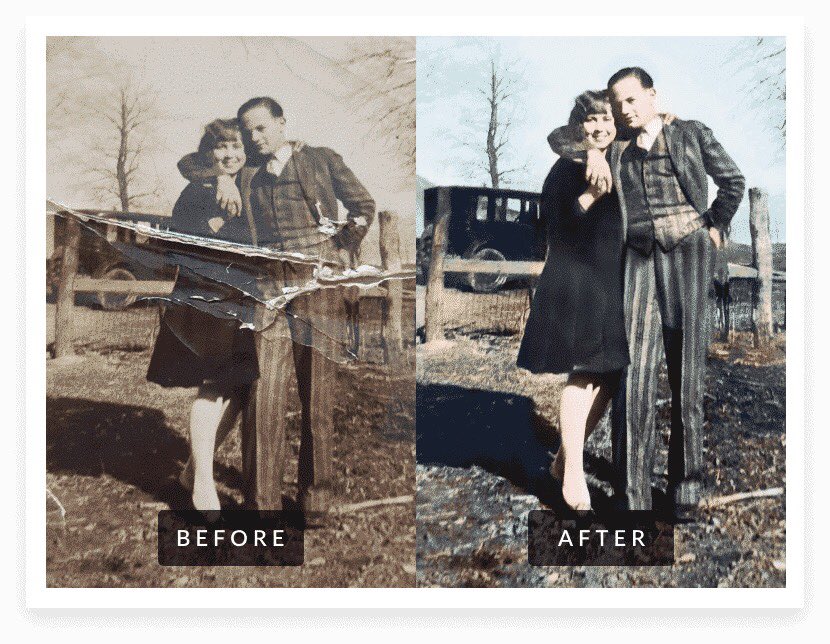Tech
Techniques in Restoring Pictures: A Comprehensive Guide
Published
11 months agoon

In a world where every moment is captured through photos, the significance of picture restoration has grown exponentially. Old photos, brimming with nostalgia and precious memories, often suffer from damage through time. This comprehensive guide will walk you through the various techniques involved in restoring pictures, ensuring that your cherished memories are preserved in their original glory. From basic touch-ups to advanced restoration, we’ll explore the myriad of methods used by professionals in the field, providing you with a solid understanding of the picture restoration process.
Importance of Picture Restoration
The importance of picture restoration cannot be overstated. As time progresses, photos may fade, tear, or accumulate stains that detract from their original quality. Picture restoration intervenes here, aiming to repair the damage and return the photograph to its former state. Restoring pictures is not just about maintaining visual fidelity, but also about preserving historical, emotional, and cultural significance. These restored images become a gateway to the past, allowing future generations to witness and appreciate a moment as it was originally captured. By performing picture restoration, we ensure that even as people and moments pass, the memories encapsulated within these photos endure.
Basic Techniques in Picture Restoration
1. Cleaning
The initial stage of picture restoration involves the careful cleaning of the photograph. It is common for photos to accumulate dust, grime, and even mold over time, which can cause significant damage. Specialized tools and cleaning solutions are used by professionals to delicately remove these contaminants, without causing further harm to the picture.
2. Repairing Physical Damage
Tears, creases, and missing pieces are common forms of physical damage that can occur to old photographs. Restoration experts use a multitude of techniques to address these issues, including digital and manual methods. Digital techniques often involve the use of software like Photoshop, where the damaged areas are filled in with details taken from undamaged parts of the picture. Manual methods might include the use of special adhesives and materials to physically mend the photograph.
3. Color Correction
Over time, photos tend to fade and lose their original color quality. Color correction is a crucial technique in the picture restoration process, striving to restore the image’s authentic colors. Through the use of digital software, restoration experts can adjust the color balance, contrast, and saturation levels of the picture to closely match its original state.
4. Image Sharpening
Lastly, to ensure the restored picture retains the maximum amount of detail, image sharpening techniques are applied. This can involve the use of digital tools to enhance the contrast along the edges within the picture, making the image appear clearer and more detailed. This final step in the picture restoration process can make the difference between a good restoration and a great one.
Advanced Techniques in Picture Restoration
5. Digital Inpainting
Digital inpainting is an advanced technique where missing or corrupted parts of a photo are filled in with plausible content. Experts use sophisticated image processing tools that analyze the photo’s surrounding area to predict the missing details accurately. This technique is especially useful in restoring pictures with missing parts or areas that have been significantly damaged.
6. Noise Reduction
Old photographs often suffer from ‘noise’—random variation of brightness or color information. Noise reduction techniques are used to mitigate this issue and improve the overall visual quality of the picture. Advanced software filters are used to identify and reduce noise, resulting in a smoother, cleaner image.
7. Reconstruction of Lost Elements
In some cases, significant elements of a photo may be lost or damaged beyond repair. This is where the reconstruction of lost elements comes into play. This technique involves a high degree of artistic judgment and skill, and may require the expert to draw upon similar images or use historical references to reconstruct the missing parts accurately.
8. Advanced Color Restoration
While basic color correction is essential, advanced color restoration takes this a step further. Experts use techniques such as color grading, selective colorization, and tonal adjustments to match the desired look of the restored picture. This not only restores the original colors but also enhances them to bring out the maximum depth and detail of the image.
Digital Tools for Picture Restoration
1. Adobe Photoshop
Adobe Photoshop is a powerful digital tool widely used in picture restoration. It offers a vast array of features ideal for restoring aged or damaged photos. Photoshop’s `spot healing` tool allows professionals to effortlessly repair minor blemishes or scratches. For more substantial damage, the `clone stamp` tool is used to replicate pixels from an undamaged area of the image and apply them to the damaged zone. Furthermore, Photoshop’s advanced color correction features and filters enable restoration experts to bring old, faded photos back to life.
2. GIMP
The GNU Image Manipulation Program (GIMP) is a free and open-source image editor. It is a versatile tool equipped with a broad spectrum of features suitable for picture restoration. GIMP’s `heal` tool helps to fix small imperfections, while its `clone` tool can be used to repair more significant damage. In addition, GIMP offers a host of color correction tools, allowing users to adjust hue, saturation, and brightness levels to restore the original vibe of the photo.
3. DxO PhotoLab
DxO PhotoLab is an advanced photo editing software that excels in noise reduction, a common challenge in picture restoration. Its robust `DeepPRIME` technology uses artificial intelligence to effectively reduce noise while preserving image detail. This tool also offers advanced light and color features, including `Smart Lighting` and `Color Protection`, to help restore and enhance the photo’s original color quality.
4. Inpaint
Inpaint is a dedicated photo restoration software that excels at removing unwanted objects or repairing missing parts of a photo. The tool reconstructs the background surface of an image by analysing the surrounding pixels. This makes it ideal for dealing with tears, stains, or missing parts of a photo. Inpaint also allows for basic color correction and texture generation, providing a comprehensive toolset for image restoration.
Preserving Restored Pictures with MemoryCherish
MemoryCherish is a renowned service for preserving treasured, restored pictures. Once your photographs have undergone the meticulous process of restoration, it is of the utmost importance to secure these revitalised memories for future generations. MemoryCherish, with its state-of-the-art preservation techniques, ensures that your restored pictures retain their renewed vibrancy and detail over time. The service provides high-quality, UV-resistant protective coverings and offers digitization services, creating backup digital copies of your pictures. This dual approach to preservation not only protects your physical photographs from future damage but also guarantees a digital safeguard of your cherished memories, easily accessible and shareable at any time.
Conclusion
In conclusion, the process of picture restoration is a delicate balance of art and science, involving a range of techniques from basic color correction to advanced digital inpainting. The use of digital tools like Adobe Photoshop, GIMP, DxO PhotoLab, and Inpaint has revolutionised the field, allowing restoration experts to bring faded or damaged pictures back to life with remarkable precision. And with preservation services like MemoryCherish, these restored pictures can be safeguarded for future generations. Whether it’s a priceless family photo or a historical image, picture restoration plays a crucial role in preserving our past and enabling us to cherish those memories for years to come.
Recent News


4 Amazing Trips for Your Family
Choosing somewhere for a family vacation that would pique the attention of adults and kids alike can be a fun...


Customising Your Makeup with Blendable Blush Options
In cosmetics, one’s face is a canvas for self-expression and creativity. Among the myriad of products available, blush is a...


The Benefits of Regular Home Maintenance
Regular home maintenance is essential for maintaining and even raising the value of your house. A proactive approach to repairs...


Understanding the Importance of SEO in Adelaide
In the digital marketplace, Adelaide businesses are in a continuous contest to gain the attention of their target audiences. With...


Breaking Down the Numbers: Understanding the Average Traveling Nurses Pay
The open road, adventure, and the chance to heal – travel nursing promises an undeniable allure. But amidst the excitement,...


Dealing with Oily Skin in Summer: Tips and Tricks
As the temperature rises, those with oily skin often face an additional challenge—maintaining a clear and balanced complexion. Excess oil...


Mountain Wedding Ideas for 2024
A mountain wedding is a stunning choice for couples who cherish nature and desire a distinctive wedding experience. Whether you...


3 Of The Best Ways To Keep Your Salon Clean
It is of the utmost importance to ensure that a salon is kept scrupulously clean, not just for the sake...


3 Reasons You Should Get Blood Tests Every Year
Regular blood tests are essential for preserving general health and identifying potential problems early on. Medical professionals can evaluate your...


How to Make Your Next Crafts Project Pop
Crafting is a creative outlet that allows individuals to express themselves through various mediums such as paper crafts, sewing, painting,...
